List of skin conditions associated with internal cancer
Jump to navigation
Jump to search
This is a list of skin conditions associated with internal cancer.[1][2] It does not include skin infections associated with cancer or cancers that spread to skin.[2] Some have stronger associations with cancers than others.[3]
| Cutaneous condition | Internal malignancy | Image | Notes |
|---|---|---|---|
| Acanthosis nigricans[3] | 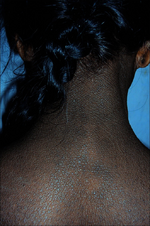
|
||
| Acquired ichthyosis[4] | Hodgkin disease | 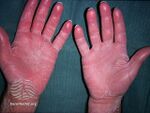
|
|
| Acrokeratosis paraneoplastica | Squamous cell carcinoma of the upper respiratory or gastrointestinal tracts | 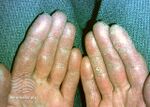 |
|
| Clubbing of fingers[3] | Lung cancer[3] |  |
|
| Dermatomyositis | Lung cancer in men, breast and gynaecological tumours in women and colorectal cancers in both sexes |  |
|
| Dermatitis herpetiformis | Lymphoma |  |
|
| Erythema gyratum repens[5] | Lung cancer, breast cancer, oesophageal cancer | 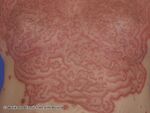 |
|
| Erythroderma and exfoliative dermatitis | Mycosis fungoides or Sézary syndrome | ||
| Hypertrichosis lanuginosa acquisita | Lung cancer | ||
| Leser–Trélat sign | Gastrointestinal adenocarcinoma | 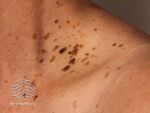 |
|
| Migratory thrombophlebitis | Pancreatic adenocarcinoma | ||
| Necrolytic migratory erythema | Glucagon secreting pancreatic islet cell adenoma | 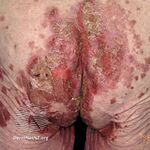
|
|
| Paraneoplastic pemphigus | Non-Hodgkin lymphoma[nb 1] Chronic lymphocytic leukemia Castleman's disease[nb 1] Sarcoma Thymoma |

|
|
| Paraneoplastic pigmentation | Small cell bronchial carcinoma | ||
| Pityriasis rotunda | Hepatocellular carcinoma | 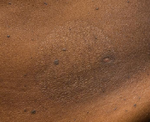 |
|
| Porphyria cutanea tarda and variegate porphyrias | Hepatocellular Carcinoma |  |
|
| Pyoderma gangrenosum | Hematological malignancy | 
|
|
| Scleroderma‐like skin changes | Carcinoid syndrome | ||
| Sweet syndrome | Hematological malignancy |  | |
| |
| Tripe palms[3] | Lung cancer, stomach cancer, ovarian cancer[3] | 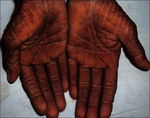 |
|
| Trousseau sign of malignancy |
Footnotes
- ↑ 1.0 1.1 Non-Hodgkin lymphoma is the most common cause of paraneoplastic pemphigus in adults. Castleman's disease is the most common cause of paraneoplastic pemphigus in children.
See also
References
- ↑ James, William D.; Elston, Dirk; Treat, James R.; Rosenbach, Misha A.; Neuhaus, Isaac (2020). "28. Dermal and subcutaneous tumors". Andrews' Diseases of the Skin: Clinical Dermatology (13th ed.). Edinburgh: Elsevier. pp. 633–634. ISBN 978-0-323-54753-6. Archived from the original on 2023-08-08. Retrieved 2023-08-07.
- ↑ 2.0 2.1 Wick, Mark R.; Patterson, James W. (July 2019). "Cutaneous paraneoplastic syndromes". Seminars in Diagnostic Pathology. 36 (4): 211–228. doi:10.1053/j.semdp.2019.01.001. ISSN 0740-2570. PMID 30736994. Archived from the original on 2022-11-21. Retrieved 2023-08-01.
- ↑ 3.0 3.1 3.2 3.3 3.4 3.5 Fonia, Athina; Baran, Robert (2021). "Cutaneous paraneoplastic syndromes with nail involvement". In Lipner, Shari (ed.). Nail Disorders: Diagnosis and Management, An Issue of Dermatologic Clinics. Elsevier. pp. 175–182. ISBN 978-0-323-70924-8. Archived from the original on 2023-08-02. Retrieved 2023-08-01.
- ↑ James, William D.; Elston, Dirk; Treat, James R.; Rosenbach, Misha A.; Neuhaus, Isaac (2020). "27. Genodermatoses and congenital anomalies". Andrews' Diseases of the Skin: Clinical Dermatology (13th ed.). Edinburgh: Elsevier. pp. 563–565. ISBN 978-0-323-54753-6. Archived from the original on 2023-08-05. Retrieved 2023-08-04.
- ↑ Bolognia, Jean L.; Schaffer, Julie V.; Duncan, Karynne O.; Ko, Christine (2021). "15. Figurate erythemas". Dermatology Essentials (2nd ed.). Elsevier. pp. 142–148. ISBN 978-0-323-70971-2. Archived from the original on 2023-08-08. Retrieved 2023-08-05.